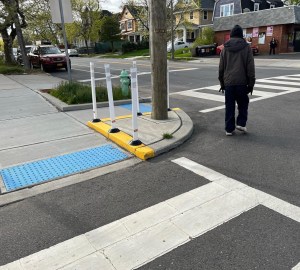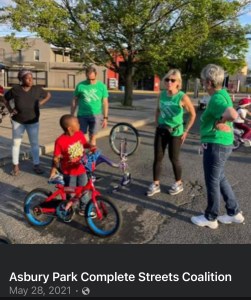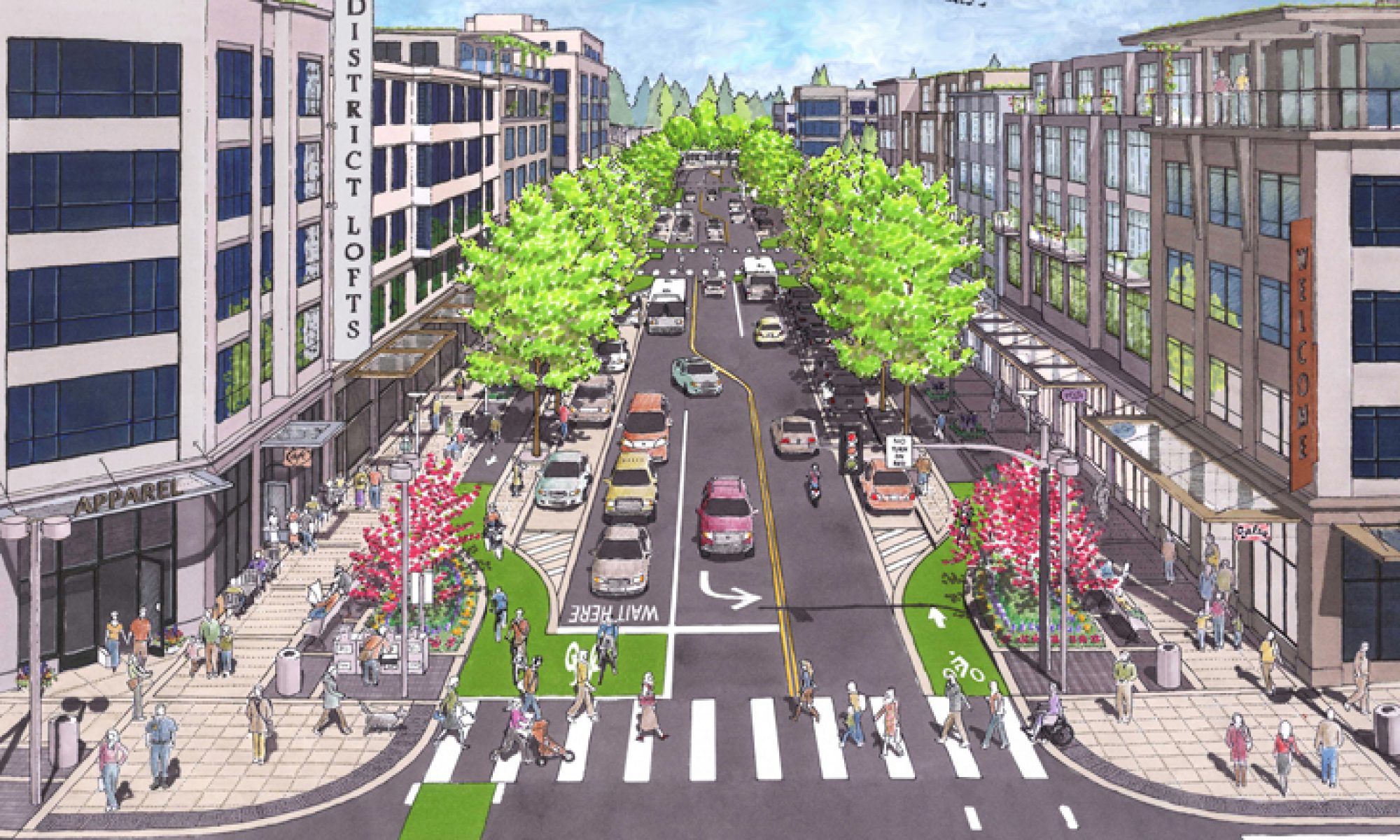Survey: How are you getting around in Asbury Park, and in Monmouth County?
Have you seen or encountered obstacles to getting around in Asbury Park, or in your city in Monmouth County?
The Monmouth County Division of Planning, Transportation and Community Services hosted an open house on Thursday, Nov. 16 asking for feedback to improve mobility throughout Monmouth County.
An interactive mapping tool that let’s you easily pick and comment on places that need imorovement: It only takes a few minutes to do it!
This open house was the first public event for Monmouth Paths Access For All, a transportation study that will evaluate existing barriers to mobility and recommend strategies to achieve equitable mobility,
We look forward to seeing the results and next steps to improving access for everyone to get around our county and Asbury Park!
Here are some obstacles we’ve experienced in Asbury Park:








We need your help to understand the mobility challenges you encounter (or that you observe) when travelling to work, school, healthcare appointments, shopping, or whenever you’re walking or rolling in Monmouth County.
Whether you drive, take public transportation, walk, bike, or use another mode of transportation, you might notice or encounter mobility barriers, such as in these photos, or traffic congestion, unsafe intersections, infrequent bus service, no bus shelters, missing sidewalks or ADA curb ramps, no bike parking, etc.
It’s easy! Use the online mapping tool to identify and comment on places with mobility obstacles in Monmouth County that you’ve noticed, or experienced yourself.
The information you provide will be vital to informing the Monmouth Path Study, a transportation planning study that will identify and develop measures to reduce or eliminate mobility barriers for Monmouth County residents.
The goal of this study is to provide guidance for the County and its municipalities to reduce or overcome existing barriers and prevent new obstacles. This will be accomplished by combining data analysis and the lived experiences of County residents to evaluate infrastructure, policy, socioeconomic, and awareness factors that can be major limitations for the traveling public. Potential outcomes of this study include strategies to improve the built environment in a variety of land-use areas within the County.
Onward~
Polli Schildge
Editor, APCSC
Rolling to school on the Bike Bus!
Get Ready For The Asbury Park Bike Bus!
This weekend I participated in an intensive training to be certified as a League Of American Bicyclists Instructor: LCI.
The League Of American Bicyclists Instructor Certification provides a solid foundation for me to initiate a bike riding program for parents and kids in Asbury Park, called Bike Bus.

Parents riding bikes with kids to school, picking up other kids along the way (like a bus does), has been catching on everywhere all over the globe. There are dozens of articles about this phenomenon from Barcelona; Portland; the Upper West Side of NYC; Montclair, NJ; Jersey City; Brooklyn and many, many more cities all over the US and the world.

It was never questioned that I could ride my bike to school as a kid, but it has become far less usual nowadays.
Many parents in Asbury Park have told me they’re afraid to let their kids ride because of traffic, so they drive them to school, which makes them traffic, which in turn creates more congestion and dangerous conditions in school zones and surrounding streets
This is a great, healthy, fun way to get kids (and their parents) out of cars.
Getting kids and parents out of cars and on bikes is a healthy way to start the school day, prepares kids’ brains to perform better in school, and builds friendships with other kids and families.
All upsides, and no downsides.
We’re not reinventing the wheel (pun intended)!
Together WE can advocate for raised crosswalks, and other creative, effective traffic calming measures around our schools.
Streets need to be designed so drivers won’t speed anywhere near or around schools, and even street closures during school hours.

I’m ready to launch the Asbury Park Bike Bus.
Want to help?
Email apcompletestreets@gmail.com
Let’s start the buzz, and stay tuned for details!

Onward!
Polli Schildge Editor/Founder APCSC
League Of American Bicyclists Instructor Seminar
News!
Asbury Park Complete Streets Coalition will host a League Of American Bicyclists Cycling Instructor seminar on November 3rd, 4th, and 5th at The Boys And Girls Club.
Bicycling in Asbury Park has been transforming over the 8 years years that APCSC has been in existence.
When APCSC was founded there was only one (very worn) bike lane in the city.
People were riding bikes for daily transportation or recreation with zero awareness of the need for safe infrastructure. Main Street was a speeding 4 lane highway, many businesses had been abandoned, and drivers ruled city streets.
Locals began advocating with us and learning how we can #slowthecars with traffic calming measures like bike lanes, bumpouts, mini traffic circles, raised crosswalks, and speed bumps. The Main Street road diet was implemented after an energetic 18 months APCSC campaign.
Streets that are safe for anyone at any age to ride a bike will encourage people to ride bikes.
Residents and visitors now are beginning to understand the need for safe bike riding infrastructure – for health, economic, and social benefits.
We still have a long way to go, but improvements are being made all over the city. During these years people have become aware of the need for equitable mobility for the most vulnerable road users – which is everyone outside of a vehicle.
Take a look at the Asbury Park Plan For Walking And Biking, particularly beginning on page 63 to see plans for the current work on Memorial Drive!
Our hope is that we might be able to encourage parents, teachers, and residents to be a part of a “Bike Bus” – a global movement in which adults on bikes pick up kids on bikes at “bus stops” all over town and guide them to school.
Here’s a video of Montclair’s Bike Bus In action on a recent Friday with 163 kids. 143 adults!
And in Williamsburg, Brooklyn: Make Way for the Bike Bus. For the school commute, families are taking to the streets with two wheels. Some have termed the movement “kidical mass.”
This is where League of American Bicyclist Instructor training comes in!
The League Seminar will equip instructors to educate members of the community, particularly parents and school kids to ride bikes confidently and safely.
Certified LCIs are empowered to teach courses that cover youth riding, how to ride confidently and legally with traffic, how to share paths and trails, motorist education, bike handling, group riding, and more.
Membership in The League Of American Bicyclists and the Smart Cycling course are prerequisites. The courses are held throughout the year in locations all over the US.
For more information, email apcompletestreets@gmail.com if you’re interested in becoming a League Certified Instructor.
Onward~
Polli Schildge, Editor APCSC
Can you NOT drive in Asbury Park?
This week, October 2-8, 2023
Porchfest was so great again this year! I love it because it brings us all together with a love of music, and especially because almost everyone gets to the porches by bike, scooter, or walking.
The city feels much safer without so many cars.

People without a car or unable to drive should be able to get to where they need to go safely and effectively. But every day, Americans who can’t drive – approximately 25 percent of the population – face significant barriers to mobility such as inadequate sidewalks, poor transit, lack of connectivity and dangerous roads. The needs of non-drivers are too-often disregarded in transportation infrastructure and policies.
Onward~
Polli Schildge Editor APCSC
Distracted Walking Is A Myth – update.
Hello readers.
I saw the immediate aftermath of a bike rider getting hit by a driver one block from our house this weekend. The bike rider himself unbelievably seemed ok, and he said “I’m sorry…” but the driver had been far exceeding the local 25mph limit.
Why would even a bike rider himself take the blame for being hit by a driver? It’s a successful campaign by the auto industry to hijack American brains.
Let’s stop blaming pedestrians and bicyclists for their injuries and deaths. Here’s the truth.
Why the ‘distracted pedestrian’ is a myth
This Curbed Article was written in 2018. This is an update.
Victim blaming much?
It’s just easier, and it suits the industry to shift the responsibility for safety off the driver, to take focus off humongous 9000lb vehicles, and away from infrastructure that is dangerous by design.
Place responsibility on the walker or on the person on a bike for their own safety. Done.
Truth: Drivers are killers. But hear me out…drivers themselves can’t be totally to blame…
Cell phones and gadgets which irresistibly distract drivers have contributed to soaring numbers of fatalities and injuries. Now cars like the 2021 Mercedes have huge dash screens, and other built-in distractions like “infotainment systems”, but car makers tell drivers to use them with caution, so oh yeah, we’re good.
Distracted driving that leads to injuries and death is a public health crisis.
A Center for Disease Control updated study cited that one in every five people killed by distracted drivers was not in a vehicle — they were walking, riding a bike, or otherwise outside of a vehicle.
Texting while driving has been said to be as dangerous as driving drunk.”
But wow this is happening! Automakers are starting to admit that drivers hate touch screens. Buttons are back!
For the past several years, huge SUVS and trucks are almost the only vehicles being built in America, so what’s a driver to do? They’re marketed with features that protect people inside the vehicles, but everyone outside the vehicle is at risk. A walker hit by a driver of a Honda Civic will probably be injured, but maybe not killed. A person walking hit by the driver of a Ford F150 will be dead.
Roads are designed for speed. Most American traffic engineering designs roads to expedite traffic: Wide roads look and feel like landing strips, which invite, and encourage drivers to speed. It’s just what happens.
Onward~
Polli Schildge Editor APCompleteStreets.org
Send your comments and share your email to: apcompletestreets@gmail.com
Meeting: Asbury Park Main St. Improvements. And A Short History Of The AP Road Diet
Ongoing improvements are planned for Asbury Park’s Main Street.
Mark your calendar to attend the Main Street Streetscape Improvements community meeting on Tuesday, August 29, from 6 to 7:30 p.m. at Council Chambers, 1 Municipal Plaza.
The Main Street reconfiguration will be complete with the addition of benches, bike racks, and trees.
The City of Asbury Park received a Federal Transportation Alternatives Program (TAP) grant to provide streetscape improvements along Main Street and Deal Lake Drive. “The proposed project will include the installation of over 100 new street trees to improve the aesthetics of the roadway. In addition, new decorative bicycle racks will be installed at various locations along Main Street.”
A Short History
Asbury Park Complete Streets Coalition began our work in 2015 when the city rejected the plan by NJDOT to implement the road diet (video explainer here) on Main Street when we read in The Asbury Park Sun that the Mayor stated rejecting the Road Diet plan was his “finest victory”.
A road diet is a reconfiguration of a roadway to allow for smoother, safer movement of traffic, easing congestion, and improving safety, with “traffic calming”.
This was the start:
Envisioning A Better Main Street.

In 2017, after about 18 months of research, communication with NJDOT, plus energetic and wide-reaching community engagement, APCSC and our supporters applauded the Mayor and city council members when the city agreed unanimously (video) to reverse their decision, and to move forward with the NJDOT $19 million planned Road Diet.
In 2021 NJDOT Commemorated the Main St. Road Diet with Director Diane Guiterrez, Lt Gov. Sheila Oliver, NJ Senator Vin Gopal, local Assembly Persons, and Asbury Park Mayor Moor, City manager Donna Vieiro, and Council members, Kendle, and Clayton, Transportation Manager Mike Manzella, and me, Polli Schildge, proudly wearing my distinctive green APCSC T-shirt!

APCSC has been showing up, gaining support and building a strong reputation across the state!














Join us!
Send your email to apcompletestreets@gmail.com
As a 1.4mile sq city, AP could be a model for a truly people-centric, walkable and rollable city. We’re looking forward to many more ongoing improvements for people walking and rolling in AP, as outlined in the Asbury Park Walk and Bike Plan.
Onward~
Polli Schildge, Editor @APcompletestreets
UPDATE on Railroad Crossing Closures: CC Meeting Video
Thanks to The Coaster for this excellent coverage of the RR crossing closure issue.
The Coaster: 3 Railroad Crossing Closures Under Review in Asbury Park

The city council meeting went well on Wednesday night 6/14- each person who spoke made very effective points. Thanks so much for stepping up to the mic!
APTV video of the City Council Meeting
Public comment segments:
29:27 – 34:30 (Polli Schildge)
38:44 – 41;29 (Michael Kushner)
42:20 – 50:30 (Rhiannon Long; Mimi Jen; Sylvia Sylvia AP Chamber Of Commerce)





✅Thank you for your letters. Continue to spread the word: Email: apcompletestreets@gmail.com. The new DOT contact is: Christopher.Yandoli@dot.nj.gov..
✅IF YOU WANT A TEMPLATE FOR A LETTER please email: apcompletestreets@gmail.com.
DOT communication with the city this week said that the closure at 6th is “on hold” now, pending more study. But it there is no guarantee that it will not be closed.
We need to stay diligently on top of this.
Onward~
Polli Schildge, APCSC Editor
Community Opposition To RR Crossing Closures in Asbury Park
Hello APCSC friends~
Since we recently learned of the slated closure of the 6th Ave grade crossing closure (and the proposed closures at 5th Ave, and 1st Ave) we have received over 60 opposition emails, which will be compiled in a document to DOT.
The city officially and adamantly opposes the closure.
Contact AP Complete Streets Coalition to oppose RR grade crossing closures: apcompletestreets@gmail.com
Contact Vanessa Meades at NJDOT from the Office of Government & Community Relations: vanessa.meades@dot.nj.gov
We appreciate the great coverage from The Asbury Park Reporter!
Proposed Railroad Crossing Closures Rile Community Members
Asbury Park Complete Streets is sounding the alarm, educating people about what is being proposed and asking community members to join with the organization to oppose the closures.

Overview:
Asbury Park’s Sixth Avenue, Fifth Avenue and First Avenue Railroad Crossings are all proposed to be closed by the NJDOT. Asbury Park’s Complete Streets Coalition says, “not so fast,” and claims the closures will not meet any one of those goals.
The study cites safety as the reason for closing grade crossings. We believe that safety would be better served if the crossings were brightly lit, with upgraded gates, and flat surfaces for bike riders, walkers, and strollers.
Polli Schildge
Asbury Park was developed as a racially segregated community, and the railroad tracks were the border. Today, this division is still present, and closing west-to-east crossings in Asbury Park will not be well-received here.
Kathleen Mumma
Asbury Park Complete Streets Coalition is committed to equitable access across the city, east to west, and north to south. for everyone.
Let’s work together to prevent any further grade crossing closures.
Contact AP Complete Streets Coalition to oppose RR crossing closures: apcompletestreets@gmail.com
Contact Vanessa Meades at NJDOT from the Office of Government & Community Relations: vanessa.meades@dot.nj.gov
Onward~
Polli Schildge, Editor
The Price Of Automotive Addiction. New Yorker Book Reviews.
What’s your main mode of transportation?
Like most Americans it’s probably vehicular.
Adam Gopnik’s New Yorker review of two new books:
Daniel Knowles’s “Carmageddon” is a serious argument against cars. Henry Grabar’s “Paved Paradise” is an anti-parking with an entertaining tilt. Both books make an argument for alternative like rapid transit, trains and trolleys, bicycles, but they mostly criticise the current systems.
“We pay an enormous price for our automotive addiction—in congestion, time wasted, neighborhoods destroyed, emissions pumped out, pleasant streets subordinated to brutal expressways—but telling the addict that the drug isn’t actually pleasurable is a losing game. There is some slight hope in saying that it isn’t healthy, and that the replacement for the drug is about as good. But understanding this emotional infrastructure in favor of cars is vital to imagining their possible replacement.
The grip of the car as a metaphor for liberty is as firm as that of guns, if perhaps with similarly destructive results.”
Any thoughts about parking? It’s the most contentious issue in many US cities. Gopnik references Donald Shoup’s 2005“The High Cost of Free Parking,”
Americans have been brainwashed to believe that they’re entitled to parking. Bitter battles about storing cars, and mis-belief that more cars = more business leads city leaders to backtrack on beneficial community projects like Open Street on Cookman Ave.


Parking has its very own official committee in Asbury Park, with enough stuff about car storage to discuss in lengthy monthly meetings. We propose a Transportation Equity Committee, but that’s another story.
Parking minimums were established by The Institute of Transportation Engineers, (which still exist in Asbury Park) whereby builders have to provide x-number of spaces for residences, and businesses, leading to cities’ swaths of asphalt dedicated to car storage, contributing in part to a housing shortage, suburban sprawl, and the development of neighborhoods where you can’t get anywhere to do or buy anything without a car.
Asbury Park is a “15 minute city”, as the now contentious concept is described in the article. It’s a walkable, rollable city, but private cars still rule. We propose on-demand transit to reduce car dependency, mitigate the parking problem, and to make our streets safer. Yes, that’s another story.
Now that parking minimums are being abolished in many cities, car owners are angry that they have to pay for it themselves. Oh the inequity of it.
What if we had reliable, affordable, convenient transit options? What if we didn’t need cars?
Read or listen to the book reviews:













